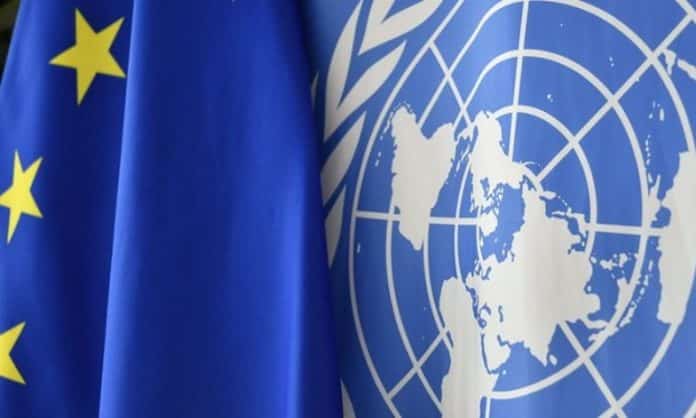The United Nations Secretary-General has recognised the European Union (EU) as “a pillar of the multilateralism system and as the most successful peacebuilding project since the end of WWII.”
“Our institutions both transcend national borders and national interests,” recalled Ursula von der Leyen, President of the EU Commission, on 13 July 2023, when she received the head of the UN in Brussels as part of an annual high-level dialogue initiated in 2022. “The world needs the United Nations now more than ever,” she declared.
Multilateralism at heart
The areas of cooperation between the EU and the UN are numerous, ranging from peacekeeping to financing for development, humanitarian action, progress towards the Sustainable Development Goals (SDGs) and climate action. In 2022, the EU and the UN worked together in more than 170 countries in various areas, including providing emergency relief addressing food security, climate change and biodiversity loss.
Evaluating the EU-UN cooperation in external action over the period 2014-2020, during a presentation on 4 December 2023, Camilla Brückner, Director of the UN/UNDP Office in Brussels and Representative of the UN System in the EU, underlined the importance of the shared value to defend multilateralism:
“The interlocking crises we are witnessing today clearly show that we must continue strengthening rules-based multilateralism. Without effective multilateralism, which includes a strong EU-UN partnership, humanity cannot solve today’s challenges, be it climate change, poverty, hunger, or rising inequalities.”
The EU, an observer at the United Nations
Since May 2011, the European Union (EU) delegation in New York has had observer status at the United Nations. Every year, the EU announces its priorities during the UN General Assembly. These priorities take into account the UN agenda as well as global issues.
When Charles Michel, President of the European Council, addressed the General Assembly on behalf of the EU on 21 September in New York, he advocated profound reforms of multilateralism.
This call for reform does not change structural cooperation between the EU and the UN: the European Council indicated that its priorities for 2024 will focus on accelerating the implementation of the SDGs, strengthening global governance and building global partnerships at a time when the world is “facing a proliferation of crises“.
The EU, one of the leading multilateral contributors to the United Nations
The United Nations system received its largest share (37%) of non-governmental contributions in 2021 from EU institutions. Other substantial contributions come, among others, from the Global Fund, private donors or the United States National Committee. These contributions are separate from the contributions of EU Member States to the UN.
Of the 3.5 billion dollars allocated in 2021 by the EU to the United Nations, the primary beneficiary agencies, which operate in particular in humanitarian action, were the United Nations Children’s Fund (UNICEF, 641 million), the International Organization for Migration (IOM, 595.5 million) and the World Food Program (WFP, 495.2 million).
The EU and its 27 Member States provide 40% of the WFP budget and are also the main contributors to the World Health Organization (WHO) budget.
Six EU countries among the top 15 contributors to the UN budget
The 193 United Nations Member States, however, remain the main contributors to the United Nations budget, amounting to $48.48 billion in 2021 (close to the GDP of Jordan, Sudan or Tunisia). Here again, the European contribution proves to be the most important.
Six EU countries stand out among the top 15 contributors in 2021: Germany ranks second ($6.1 billion) after the United States ($12.5 billion). Sweden, France, Italy, Denmark and the Netherlands are the 3rd, 8th, 10th, 11th and 12th contributors. These six countries contribute 27.2% of the United Nations budget, with the United States contributing 25.7%, Japan 5.6% and the United Kingdom 4.1%.
In total, 42% of the UN’s total funding from 2014-2020 came from Europe, recalls Camilla Brückner. The crucial aspects of this UN-EU cooperation are the “promotion of universal norms and values, impartiality, the committing power, an extensive presence on the ground, and established relations with local and national counterparts”.
Financing for Development
According to the Organisation for Economic Cooperation and Development (OECD), the total number of official development assistance (ODA) from EU institutions ($23.1 billion, or 11.3% of total ODA) increased by 30.3% in 2022 due to support for Ukraine – partly in the form of loans.
EU institutions are third among the 32 members of the Development Assistance Committee (DAC) after the United States and Germany. In 2021, they also had one of the highest proportions of bilateral ODA (from one country to another) allocated to Africa (37.1%).
Progress towards the SDGs
Europe’s total official development assistance, including the EU and Member States, is the largest in the world ($70.2 billion in 2022). It is closely linked to the multilateral SDG 2030 agenda, which the EU claims as the framework for “all its actions”.
Europe contributes to progress towards the SDGs within its borders and internationally through its Global Gateway initiative. This 2021-27 strategy involves 300 billion euros of investments in support of sustainable development in emerging countries and the developing world. “The time for bold and audacious action has arrived,” Amina Mohammed, UN Deputy Secretary-General, declared on 26 October during the Global Gateway Forum in Brussels.
In its first voluntary review of progress towards the SDGs, published last July, the EU draws up a detailed assessment of its international action for each of the 17 SDGs.
Climate action
The EU represents the world’s leading source of public climate finance, with a contribution of 23 billion euros in 2021, out of the 84 billion euros per year promised in 2015 by developed countries to developing countries during the Paris Agreement.
In Sudan and Nepal, the EU and the UN are developing risk management tools in the face of climate fragility, likely to be used in the Sahel and the Lake Chad region. The EU is also working with the UN Refugee Agency (UNHCR) and the International Organization for Migration (IOM) on population displacements caused by climate change.
USEFUL LINKS

